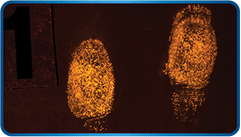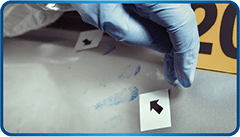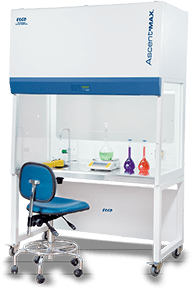Finding Fingerprints

A fingerprint easily leaves a mark or residue on any exterior. It can be found on any solid surface including the human body which makes it vital in criminal investigations. Before analysis, fingerprints are classified based on the following types:
-
SOFT SURFACES IMPRINTS
Prints found in wax, paint, chalk, and soap.
-
PATENT PRINTS
Visible prints that are created when blood, dirt, ink, etc. are transferred from a body part to a surface.
-
LATENT PRINTS
Invisible prints that are created when the body’s natural oils or sweat are transferred onto various surfaces.
COLLECTING FINGERPRINTS
Patent Prints
Fingerprints are collected through high-resolution photography. Light sources or dyes may be used during collection for improved quality.

Latent Prints
Since latent prints are not easily detected, several special techniques are used:

DUSTING
Fingerprint powders such as black granular, titanium oxide, aluminum and black magnetic are used to dust non-porous surfaces. Once prints appear, it is then lifted with an adhesive tape and transferred to a latent card for print preservation.

ALTERNATIVE LIGHT SOURCE
Alternate Light Source (ALS) are LED devices which emit a specific light wavelength. Commonly used with powders and dye stains to make prints more visible.

CYANOCRYLATE
Non-porous surfaces are exposed to cyanoacrylate or superglue fumes before the application of powders or dye stains. Once the vapor adheres to the print, it can easily be viewed with any light source.

CHEMICAL DEVELOPERS
To reveal latent prints in porous surfaces such as paper, fabric, untreated wood, and sponge, chemicals are used to start a reaction with the amino acid and salt residues present in the fingerprints.
COMMON CHEMICAL DEVELOPERS:

NINHYDRIN
Ninhydrin is a powder soluble in acetone or ethanol. It is used to determine the presence of amino acids or amines. The reaction produces a deep blue or purple dye called Ruhemann’s purple.
-min.png)
1,8-DIAZAFLUOREN-9-ONE (DFO)
Similar to Ninhydrin, DFO also reacts with amino acids. Prints that are developed using DFO glow when exposed to blue-green light. To enhance quality, prints are photographed through red or orange filters.

LUMINOL
Luminol is known to detect prints that came in contact with blood. Suspected surfaces are activated by wiping it with bleach and luminol solution. Prints will then glow signifying the oxidation process. Blacklight is used to enhance the print’s visibility.
Finding fingerprints exposes analysts or forensics scientists to a variety of chemicals and particles. To reduce the risk of inhalation and minimize chemical exposure, it is advisable to perform applicable tests inside a chemical containment equipment - a ductless fume hood. Esco’s Ascent™ Max Ductless Fume Hood E-Series (ADC-E) is equipped with carbon filters that effectively adsorb chemical fumes, vapor, and has an exhaust HEPA filter that filters and removes particles or chemicals in powder form. This principle provides operators with safety and convenience.

ADC-E
Read more here: Forensics, In the Loop: Finding Fingerprints
References:
[1] T. Allen Miller. Dusting for Prints. https://www.safariland.com/fingerprint-powder-guide.html
[2] Forensic Chemistry. (2019). https://sciencemonk.com/forensic-chemistry-applications-of-forensic-chemistry/#Identification_Of_Drugs_And_Poisons
[3] A simplified guide to fingerprint analysis. http://www.forensicsciencesimplified.org/prints/how.html
[4] Michael E. Carpenter. (2017). Ingredients in Fingerprinting Powder. https://sciencing.com/ingredients-fingerprinting-powder-8592401.html